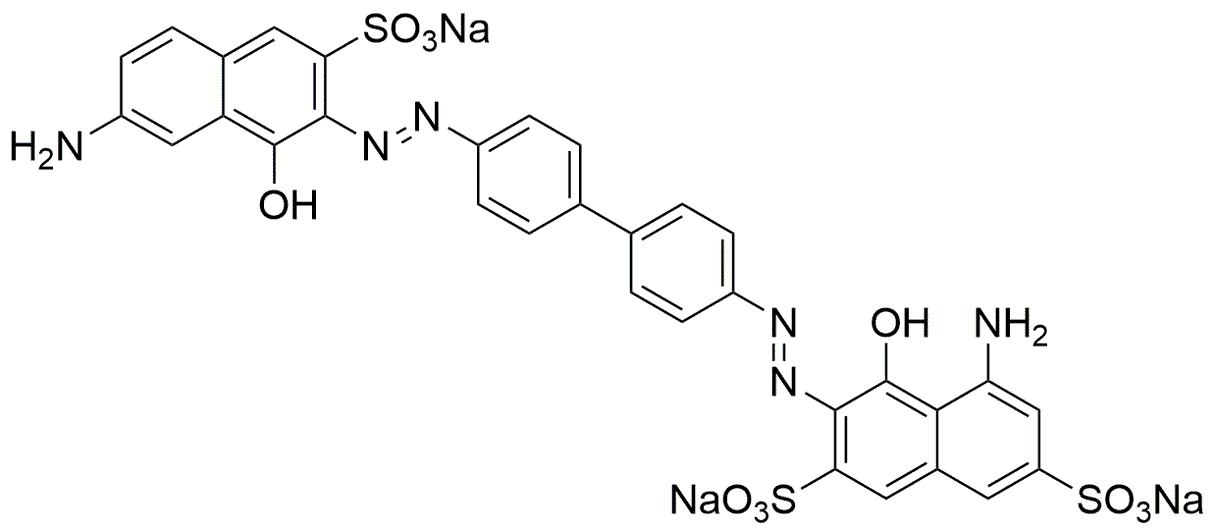Direct blue 2 is widely utilized in research focused on:
- Dyeing Textiles: This compound is primarily used in the textile industry for dyeing cotton, wool, and silk, providing vibrant blue shades that are durable and resistant to fading.
- Biological Staining: In laboratories, it serves as a staining agent for biological samples, helping researchers visualize structures in microscopy, particularly in histological studies.
- Environmental Monitoring: Direct blue 2 is employed in water quality testing, where it helps detect the presence of pollutants and assess the effectiveness of wastewater treatment processes.
- Food Industry: It is sometimes used as a colorant in food products, ensuring compliance with safety regulations while enhancing visual appeal.
- Research in Chemical Synthesis: The compound is utilized in various chemical synthesis processes, providing a model for developing new dyes and pigments with improved properties.
General Information
Properties
Safety and Regulations
Applications
Direct blue 2 is widely utilized in research focused on:
- Dyeing Textiles: This compound is primarily used in the textile industry for dyeing cotton, wool, and silk, providing vibrant blue shades that are durable and resistant to fading.
- Biological Staining: In laboratories, it serves as a staining agent for biological samples, helping researchers visualize structures in microscopy, particularly in histological studies.
- Environmental Monitoring: Direct blue 2 is employed in water quality testing, where it helps detect the presence of pollutants and assess the effectiveness of wastewater treatment processes.
- Food Industry: It is sometimes used as a colorant in food products, ensuring compliance with safety regulations while enhancing visual appeal.
- Research in Chemical Synthesis: The compound is utilized in various chemical synthesis processes, providing a model for developing new dyes and pigments with improved properties.
Documents
Safety Data Sheets (SDS)
The SDS provides comprehensive safety information on handling, storage, and disposal of the product.
Product Specification (PS)
The PS provides a comprehensive breakdown of the product’s properties, including chemical composition, physical state, purity, and storage requirements. It also details acceptable quality ranges and the product's intended applications.
Certificates of Analysis (COA)
Search for Certificates of Analysis (COA) by entering the products Lot Number. Lot and Batch Numbers can be found on a product’s label following the words ‘Lot’ or ‘Batch’.
*Catalog Number
*Lot Number
Certificates Of Origin (COO)
This COO confirms the country where the product was manufactured, and also details the materials and components used in it and whether it is derived from natural, synthetic, or other specific sources. This certificate may be required for customs, trade, and regulatory compliance.
*Catalog Number
*Lot Number
Safety Data Sheets (SDS)
The SDS provides comprehensive safety information on handling, storage, and disposal of the product.
DownloadProduct Specification (PS)
The PS provides a comprehensive breakdown of the product’s properties, including chemical composition, physical state, purity, and storage requirements. It also details acceptable quality ranges and the product's intended applications.
DownloadCertificates of Analysis (COA)
Search for Certificates of Analysis (COA) by entering the products Lot Number. Lot and Batch Numbers can be found on a product’s label following the words ‘Lot’ or ‘Batch’.
*Catalog Number
*Lot Number
Certificates Of Origin (COO)
This COO confirms the country where the product was manufactured, and also details the materials and components used in it and whether it is derived from natural, synthetic, or other specific sources. This certificate may be required for customs, trade, and regulatory compliance.

